Best Fender acoustic guitars 2025: Our top picks from Fender’s expansive range of acoustics
Whether you’re looking for an impressive jack-of-all-trades or a miniature dreadnought, Fender has an acoustic for you
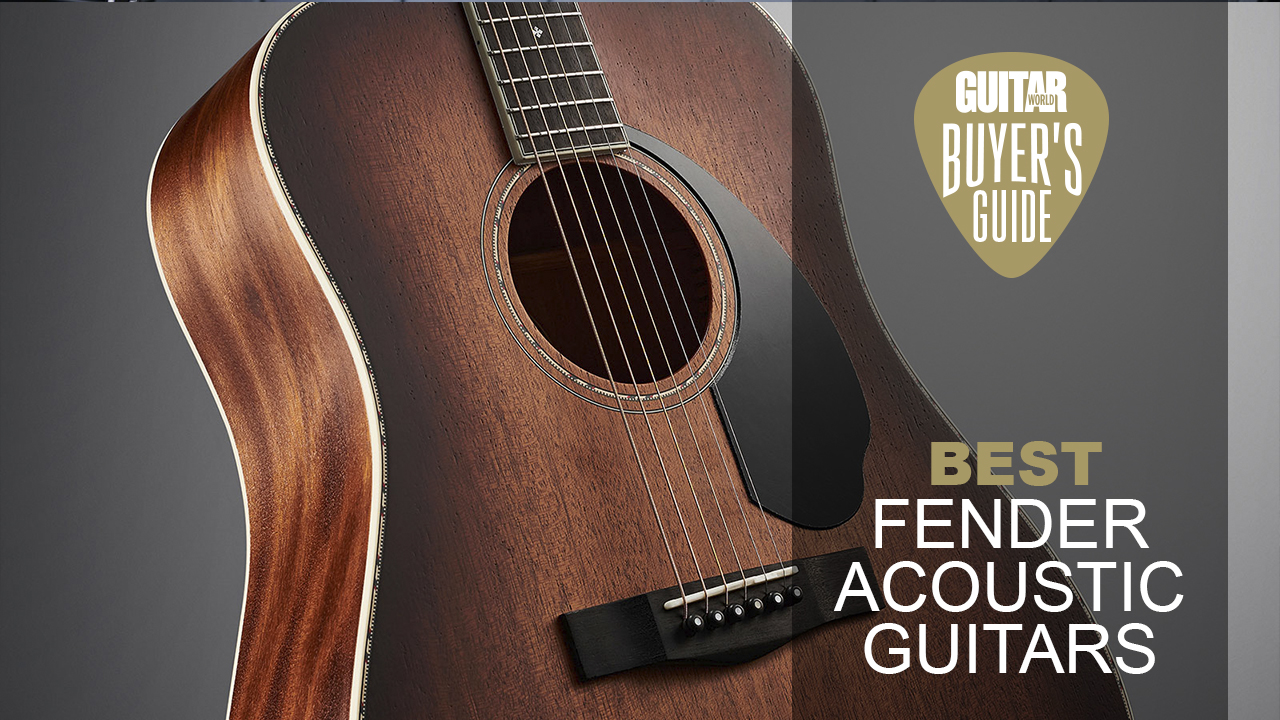
When it comes to established and well-respected electric guitar brands, Fender is probably the first name that springs to mind. However, in the realm of acoustic guitars, the Californian giants usually aren’t the first brand that people will think of. This is understandable considering that heritage brands like Martin and Taylor have dominated the acoustic corner of the guitar world for decades. However, we’re here to tell you that one of the best Fender acoustic guitars in this guide may be the perfect choice for you.
Fender's acoustic guitar history has been an interesting journey. Initially designed in the early '60s by former Rickenbacker master luthier Roger Rossmeisl, Fender's first foray into acoustic guitars aimed to breathe new life into the traditionally conventional acoustic guitar market. Inspired by the carefree, beach-going attitude of 1960s California, Fender released models like the Malibu and Newporter. These models featured their iconic 6-in-line headstock that caused a stir among acoustic traditionalists, which still happens to this day!
After discontinuation in the 1970s, Fender re-introduced their acoustic guitars back to the market in the late '80s after the company's tumultuous start to the decade. Today, Fender has been committed to releasing a wide range of acoustic guitars, including budget-friendly options and high-end, innovative instruments.
Today we are going to take a closer look at the some hand-picked Fender acoustics currently on the market. Taking into account their price point, features, and benefits, by the end of this guide we are confident you will find an option suitable for your needs.
Best Fender acoustic guitars: Guitar World recommends
For sheer value for money, you don't need to look much beyond the Fender Paramount PD-220E Dreadnought. Competitively-priced in the mid-range acoustic space, the PD-220E is a solid wood guitar that delivers weighty low-end, mid-range punch and looks the business. You even get a molded hard case thrown in.
For the experienced player looking for an acoustic guitar that can do it all, the Fender American Acoustasonic Jazzmaster is a great premium option. Using state-of-the-art Acoustic Engine technology, this hybrid Jazzmaster is capable of producing luscious acoustic tones to soaring lead lines. An acoustic guitar has never been so versatile and we believe the higher price point is well justified because of its versatility and comfortable playability.
If you’re a fresh-faced beginner then check out the Fender CD-60S. A well-articulated dreadnought with a solid top for under $200? You’re not going to get a better beginner acoustic guitar to learn to play on than this.
Best Fender acoustic guitars: Product guide
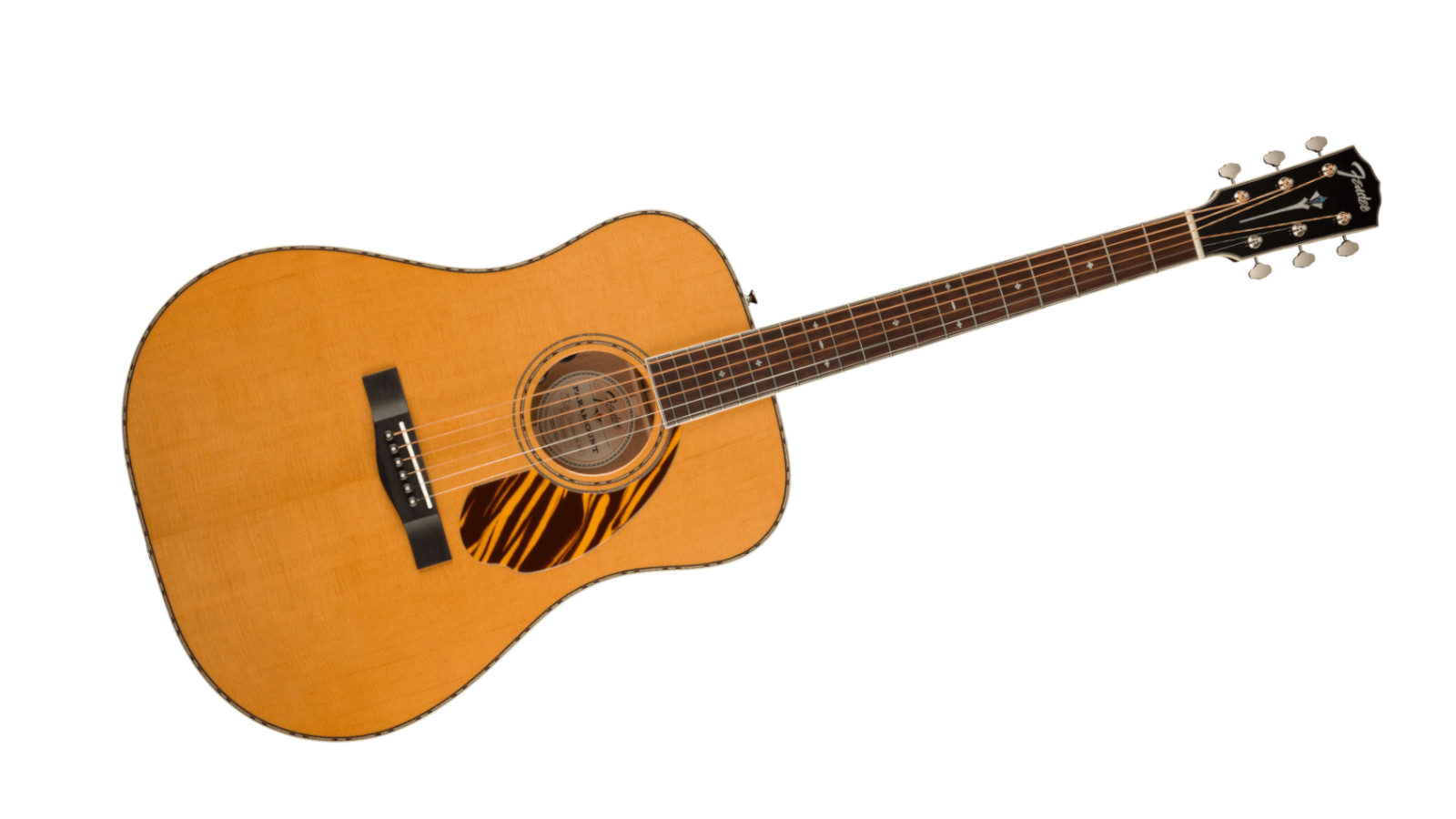
Specifications
Reasons to buy
Reasons to avoid
The mid-priced dreadnought acoustic market is a crowded one, with Martin and Yamaha taking up a lot of the space. However, Fender’s Paramount PD-220E is a completely solid wood option that deserves some spotlight.
The 3-Color Sunburst and Natural finishes both come with a solid Sitka spruce top and solid mahogany back and sides. Like any dreadnought worth its salt, the PD-220E has a clearly defined midrange with plenty of low-end oomph.
The Aged Cognac Burst is fully mahogany and is quintessentially warm, which is particularly “woody” in character and pronounced in the lower midrange. If you’re looking for a slightly spankier high-end, the Natural or 3-Color Sunburst options have solid Sitka spruce tops which offer a little more sparkle.
With the newly designed Paramount range, Fender set out to pay their respects to the classic acoustic guitar of the ‘30s – an era that transformed the acoustic into how we recognize it today. Most noticeably influenced is the feathered, checkered purfling that hugs the guitar’s edges. The rosette features a similar design and we appreciate the attention to detail Fender has included.
Like all models in the Paramount range, the PD-220E comes with a molded hard case to keep your axe safe. Overall, this is a fantastic mid-range dreadnought that deserves more attention than it's given.
Read the full Fender Paramount PD-220E review
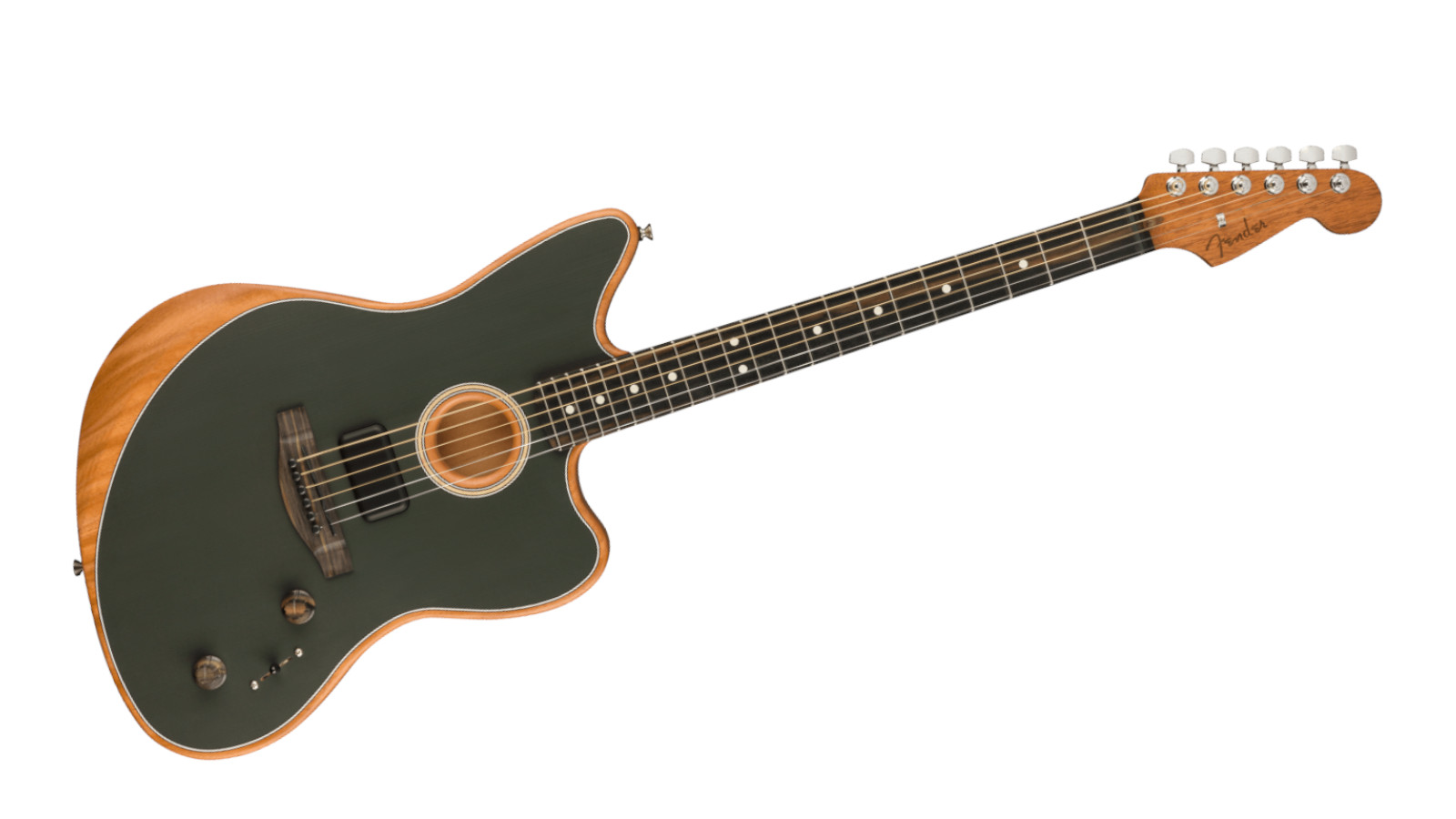
Specifications
Reasons to buy
Reasons to avoid
The Fender Acoustasonic range has its fair share of admirers and detractors, and we're definitely in the former category. So when Fender announced that they were releasing a Jazzmaster in this trailblazing range, you bet we were excited.
Boasting the largest body in the Acoustasonic range, the Jazzmaster is the most resonant of the bunch. We understand that the Acoustasonic player will primarily be playing amplified, but rest assured, acoustically this guitar is louder than it looks. The larger body size produces a richer tone than its predecessors and there is a much more pronounced low end.
Kitted out with a satin solid Sitka spruce top – try saying that five times in a row – and mahogany back and sides, this guitar feels very comfortable. The smooth contours allow for hours of playing without any arm fatigue and it is well-balanced on your lap.
Fender collaborated with acoustic pickup superstars Fishman to create the Acoustic Engine found in the Acoustasonic series. This advanced electronic system allows the user to blend acoustic and electric guitar tones. Powered by Fishman’s Aura technology, there is a five-way selector switch that will cycle through the guitar’s different tones. The mod control will allow you to choose between two different voicings – A or B – and acts as a blend knob between the two, opening up incredibly unique tonal possibilities
There are three pickups in total including an under-saddle piezo and an internal body sensor pickup; however, the Shawbucker is the standout. It is much thicker and warmer than the Noiseless single coil found on the Stratocaster and Telecaster Acoustasonics and packs a mighty punch. This may not be to every acoustic player’s taste, but it’s definitely a lot of fun.
For experienced players looking to streamline their guitar collection without sacrificing versatility, playability or comfort, the Acoustasonic Jazzmaster is the premium option to beat.
Read the full Fender American Acoustasonic Jazzmaster review
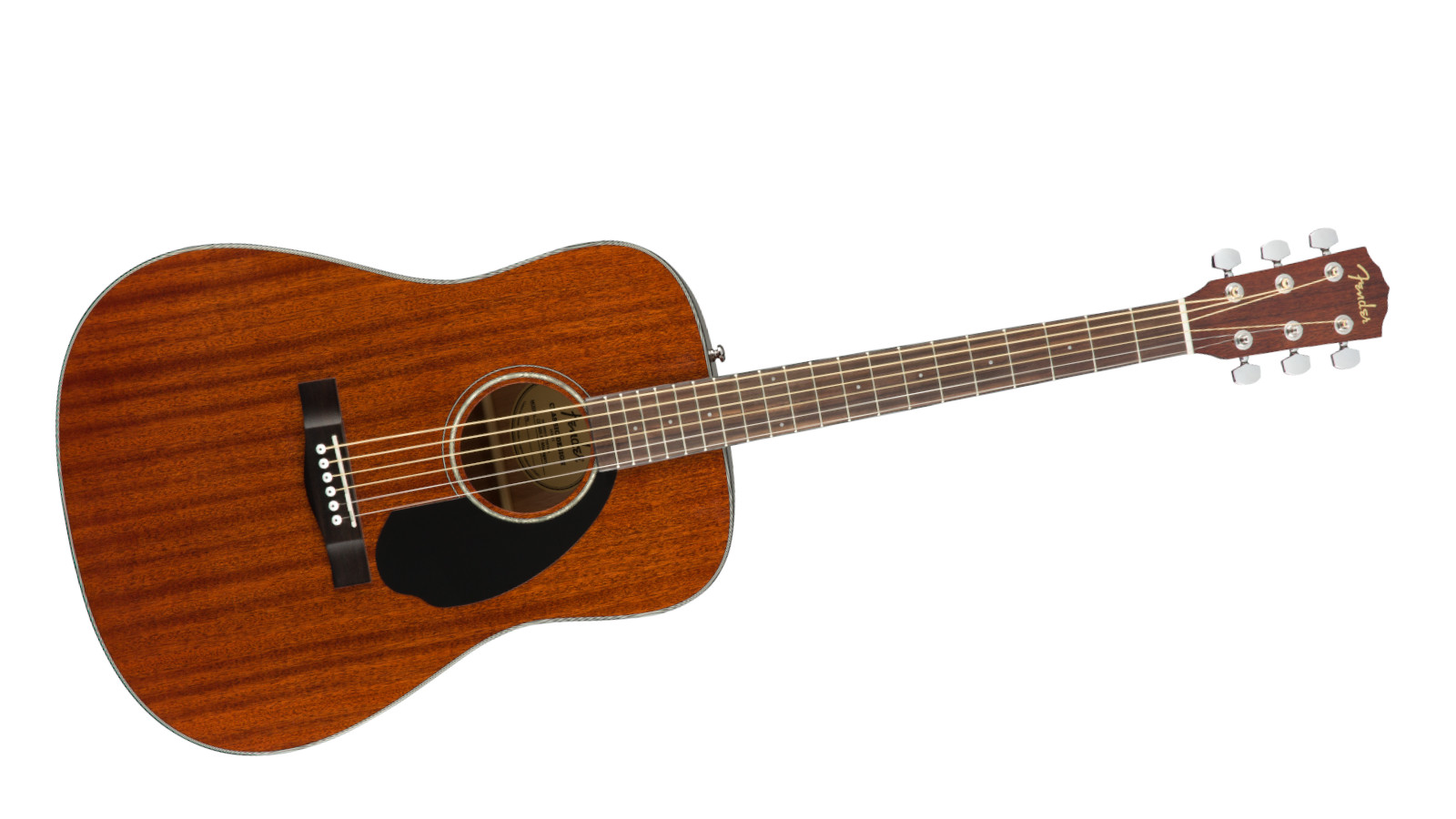
Specifications
Reasons to buy
Reasons to avoid
Looking for an affordable acoustic guitar that will take you from beginner to intermediate playing? Look no further than the Fender CD-60S.
With a solid mahogany top and laminated mahogany back and sides, this all-mahogany guitar offers a warm, woody tone that's perfect for singer-songwriters. A solid top is a feature that usually demands a higher price tag, so you’re definitely getting good bang for your buck.
The rolled fingerboard edges are another premium feature on the CD-60S and are paired with a comfortable ‘easy-to-play’ shaped neck which feels great even in an experienced player’s hands. Long gone are the days of learning on terrible acoustic guitars which would send even the most resolute learners running.
The dreadnought body delivers a big, full-bodied acoustic sound that projects across a room. The deep body and the scalloped bracing result in a pleasant boom when you strike a chord and is very prominent in the low end. Be warned, however, this is a big guitar so it’s not the best suited for smaller players.
If you prefer a brighter acoustic you can always go for the solid spruce top CD-60S. Available in a natural or black finish, the spruce version commands the same price tag as its mahogany sibling. Fender has smashed a home run with the CD-60S, and for value for money you can’t beat it.
Read the full Fender CD-60S All Mahogany review
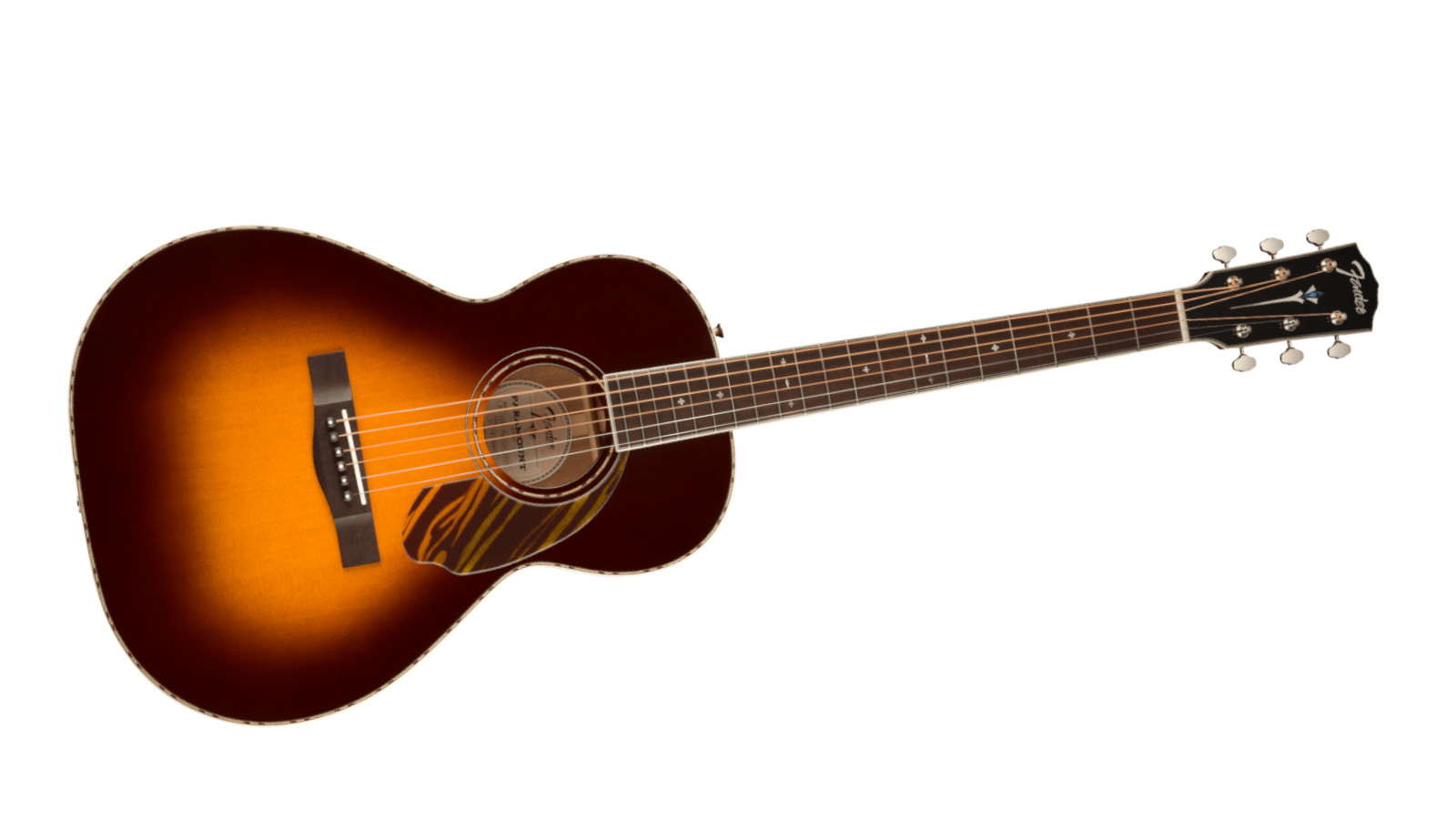
4. Fender PS-220E Parlor Acoustic
Our expert review:
Specifications
Reasons to buy
Reasons to avoid
The Paramount series is at the top end of Fender’s acoustic range, and in it are plenty of classy guitars. None more so than the PS-220E Parlor. With its small body, flattop design, and exquisite details like feathered purfling, soundhole rosette and snowflake pearloid fingerboard inlays, this guitar is as visually stunning as it is sonically impressive.
Although this isn’t an American-made Fender – which will upset a few folks because of its price – you can’t argue with the premium materials used in its construction. The solid Sitka spruce top, solid mahogany back and sides and Fishman Sonitone pickup are hallmarks of a premium quality guitar.
While the PS-220E Parlor's small size may have some sonic limitations, the offset X-bracing pattern maximizes the resonance of its top for extra movement. This little gem packs plenty of punch and sits prominently in the midrange, ensuring you'll be heard loud and clear. If you manage to try this guitar, stick it in open G as it sounds beautiful.
The PS-220E comes in three different finishes. The Natural and 3-Color Vintage Sunburst both have a solid Sitka spruce top for extra spank, whereas the Aged Cognac Burst is all solid mahogany for a little extra warmth. We love that Fender offers the PS-220E with different configurations, meaning that there will be a version to suit your tastes.
On top of all the great details mentioned above you get a sturdy hardshell case which fewer and fewer guitars come with nowadays.
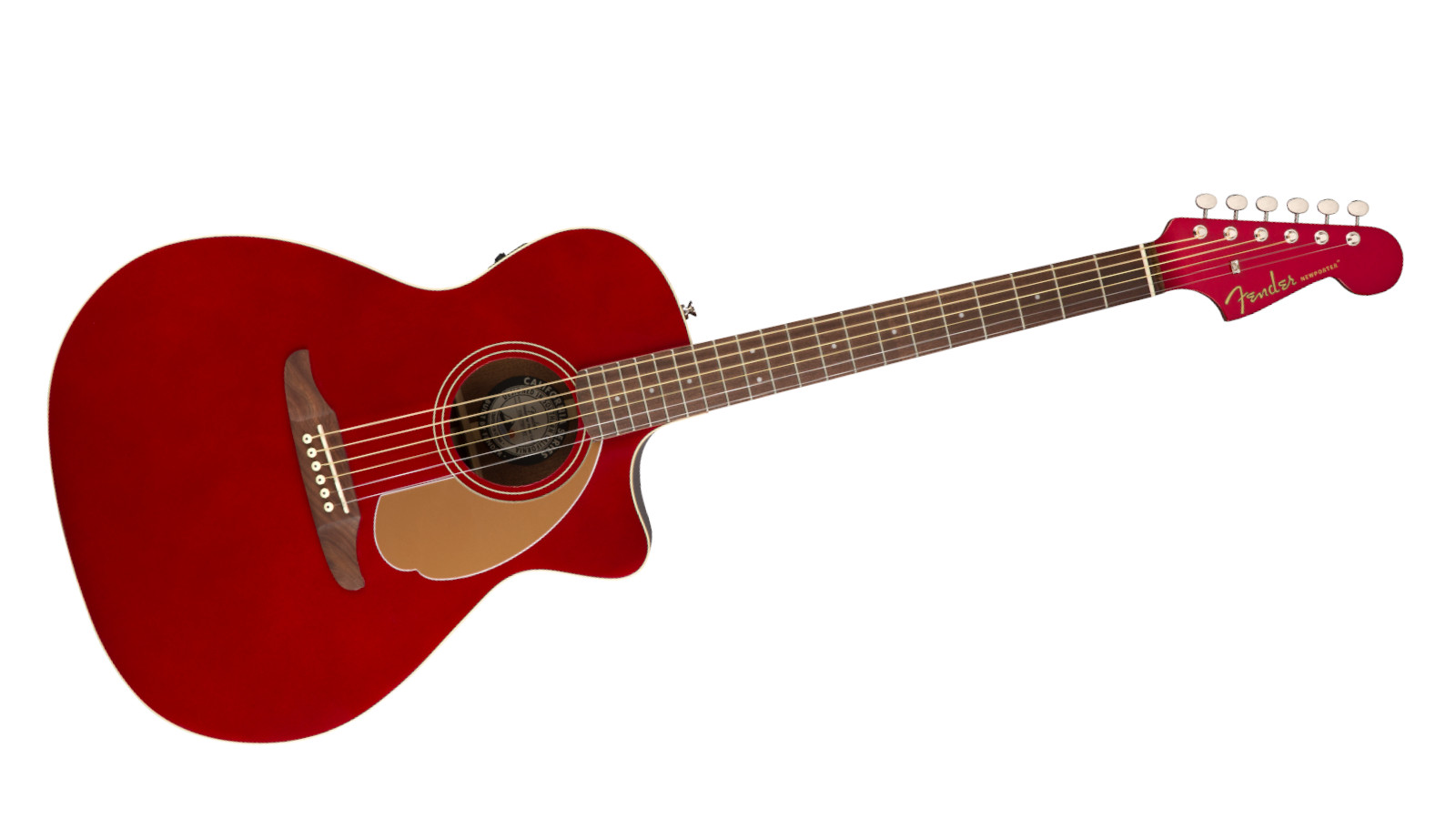
5. Fender California Series Newporter Player
Our expert review:
Specifications
Reasons to buy
Reasons to avoid
Although Fender has been around since the 1940s, it isn't set in its ways, sticking to boring tradition after boring tradition. This is perhaps most evident in the California series.
With an array of bold finishes and sweet matching headstocks, the California series sees Fender take inspiration from its past and propel itself straight into the 21st century. The Newporter is a Fender-exclusive shape and is a medium-sized auditorium body. Every aspect of this guitar is sleek, particularly the neck which is a slim-taper "C"-shaped profile, very reminiscent of their electrics.
If the neck shape is reminiscent of their electrics, the 6-in-line headstock is a complete copy and it does make for a unique look that you’ll either love or hate. The wood choice is somewhat predictable with laminated mahogany back and sides and a familiar solid spruce top.
Since this is a slim-bodied guitar, don’t expect a big thunderous low end – but do know that the Newporter Player has plenty of high-end zing with a spanky tonality to suit an array of playing styles.
The Fishman CD-1 pickup is a nice touch that shouldn’t be overlooked. We found the built-in tuner to be pretty reliable and the pickup replicated the guitar’s sound well when amplified. This lightweight guitar would be a brilliant option to take to your local open mic night.
The Newporter’s unique aesthetic is further pushed by the six different bold finishes. We love the Candy Apple Red but if you’re into something a bit more subdued, Fender does offer it in Natural.
Read the full Fender California Series Newporter Player review
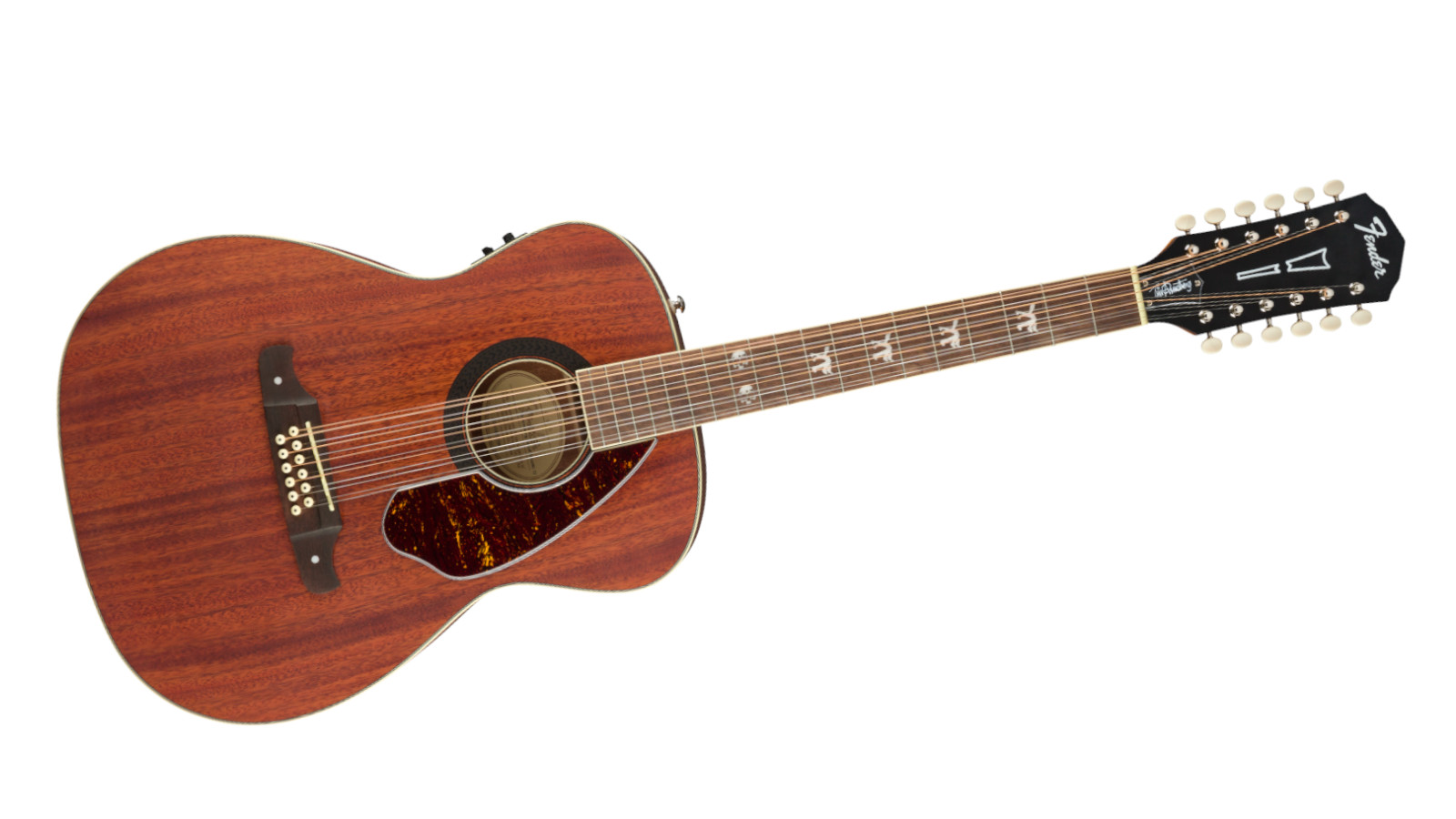
6. Fender Tim Armstrong Hellcat - 12-string
Our expert review:
Specifications
Reasons to buy
Reasons to avoid
Tim Armstrong has been the lead songwriter for the punk band Rancid since 1991. For the past three decades, he has relied upon his original 1960s Fender acoustic for inspiration. Fender has already paid homage with a 6-string re-issue but we believe this 12-string variant is a whole lot more fun.
With pearl acrylic Hellcat inlays and dual skulls at the 12th fret, this thing screams attitude. The Fender Tim Armstrong Hellcat has been purposely designed to stand out from the crowd, and the ‘70s style rosette and 4-Ply Tortoiseshell help tie the look together.
You are getting a solid mahogany top, laminated mahogany back and sides, Graph Tech NuBone nut and a Fishman Isys III pickup system in this concert-sized signature. Although a little quieter than a dreadnought, this guitar has plenty of pleasing natural harmonics and will still bark when you dig in a little.
Although we love the look of the vintage-style headstock, the tuning pegs aren’t the best quality and could potentially do with an upgrade down the road.
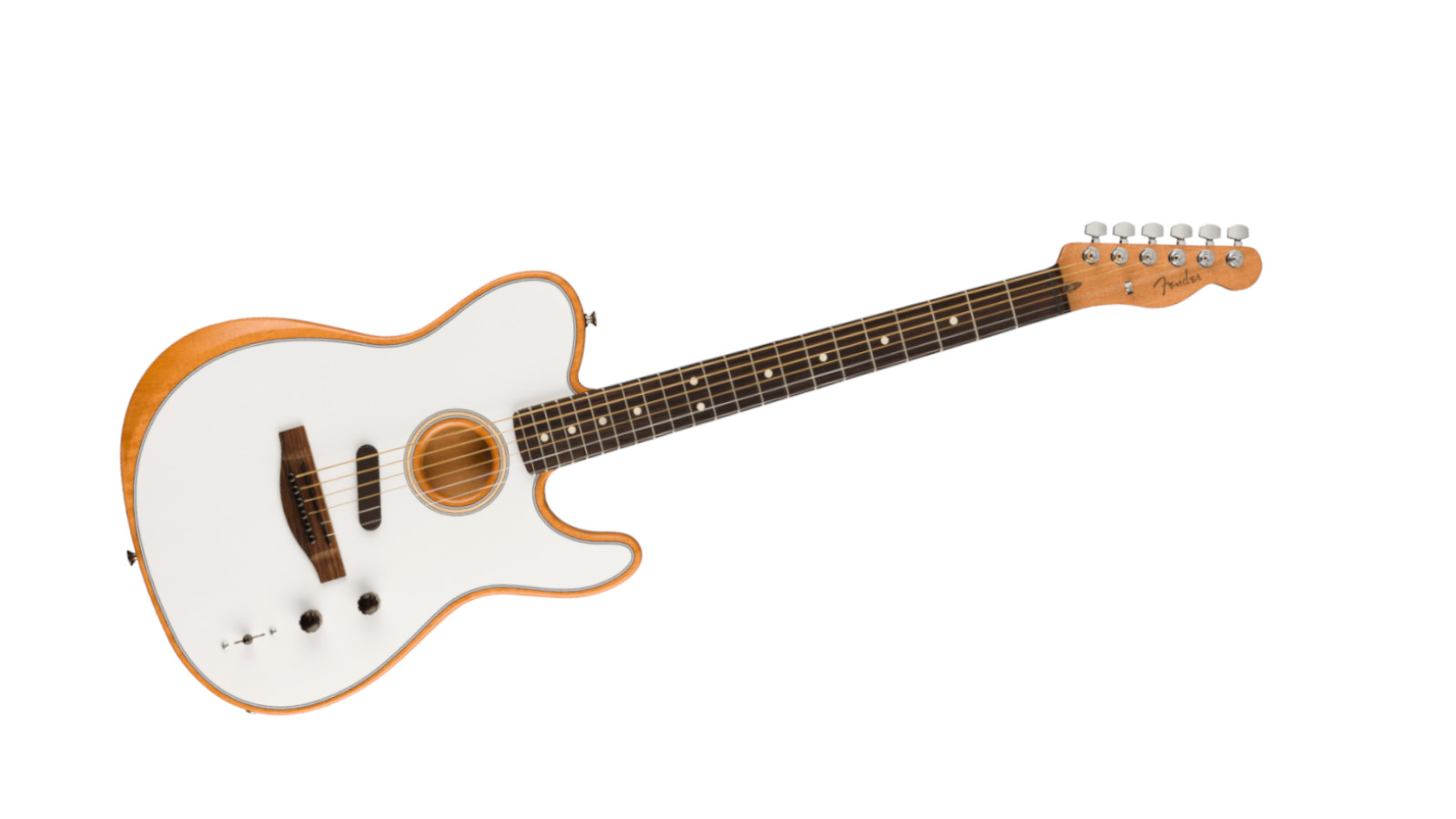
Specifications
Reasons to buy
Reasons to avoid
If you’ve had your eye on an Acoustasonic but don’t want to drain your savings, Fender has you covered. The Acoustasonic Player series delivers the heart and soul of its American counterpart but has been assembled in their Ensenada factory in Mexico.
Although the Fishman Acoustasonic Enhancer has been dropped and there are only six blendable voices instead of 10 via a three-way selector switch, the Player’s core design remains the same. The ‘tuned’ soundhole is present, it sports the same modern deep C-shape neck profile and the Acoustic Engine still functions, although with fewer options.
Fender has opted for a Rosewood fingerboard on the Player as opposed to Ebony, but for a lot of people this will be a preferable swap. If you love having as many tonal options as possible, the American version will be more suitable. However, if option paralysis is something that suffocates your creativity, six voicings will be more than enough.
When plugged in, you’ll be hearing an under-saddle piezo for warm and organic acoustic tones. For the electric sounds, Fender has implemented a noiseless N4 single coil which gives a flavorful, full-bodied single-coil bite. One of the only downsides of the Player Acoustasonic is the fact it’s battery-powered. Don’t get caught out with a dead battery on stage.
Read the full Fender Acoustasonic Player Telecaster review

8. Fender FA-15 Steel 3/4 Size
Our expert review:
Specifications
Reasons to buy
Reasons to avoid
Look, if you’ve been playing for decades and have a Gibson J-45, Martin D-28, and a Lowden O-21 at your disposal, then the Fender FA-15 isn’t for you. However, we’ve picked it because it’s a fantastic option for young beginners to dip their toes in the world of acoustic guitar.
The FA-15 is a 3/4 size guitar with a 23.3” scale length, perfect for younger children. With a small dreadnought-style body, this will give the budding guitarist in your life the perfect chance to get familiar with the instrument. It’s comfortable, has been set up well, and even comes with an additional gig bag so you can take it to lessons.
Another category of player this will appeal to is the traveling guitarist. Its small stature makes it easy to sling on your back and take on your journeys. Sure everyone staying at your hostel accommodation will hate you but it will keep your fingers moving and quell your guitar-playing appetite.
There are four finishes available that cover a laminated agathis top and laminated sapele back and sides. You usually see nato pop up on more affordable guitars and Fender has utilized that wood on the FA-15’s neck. Although these are cheaper materials, the guitar is sturdy enough to survive even the most carefree child or an intense gap year of self-discovery.

9. Fender FA-345CE Auditorium Acoustic
Our expert review:
Specifications
Reasons to buy
Reasons to avoid
The Fender FA-345CE is an ideal option for the guitarist who loves the look of uniquely figured exotic wood but doesn’t want to remortgage their house to afford it.
Addressing the elephant in the room straight away, this is an all-laminate guitar. Some may shake their head in disgust; however, if you can look past that, the FA-345CE offers plenty of value.
Fender has used a laminated flamed maple top and laminated lacewood back and sides. Lacewood is an interesting choice and it is usually quite strikingly figured and makes an aesthetically pleasing match with the top.
This guitar is part of the FA series, as indicated by the '3+3' headstock, and it also boasts a Viking bridge and tortoiseshell binding for added detail and a touch more pizazz.
There is a Fishman CD-1 preamp and pickup installed and the cutaway allows easier access to the higher frets. If you usually find yourself down that end of the neck, this will feel right at home and comfortable.
One of the standout qualities of the Fender FA-345CE is its exceptional natural tone. Although its auditorium body is a bit smaller than a dreadnought, it still delivers impressive note articulation and a resonant, vibrant character.
Best Fender acoustic guitars: Buyer's advice
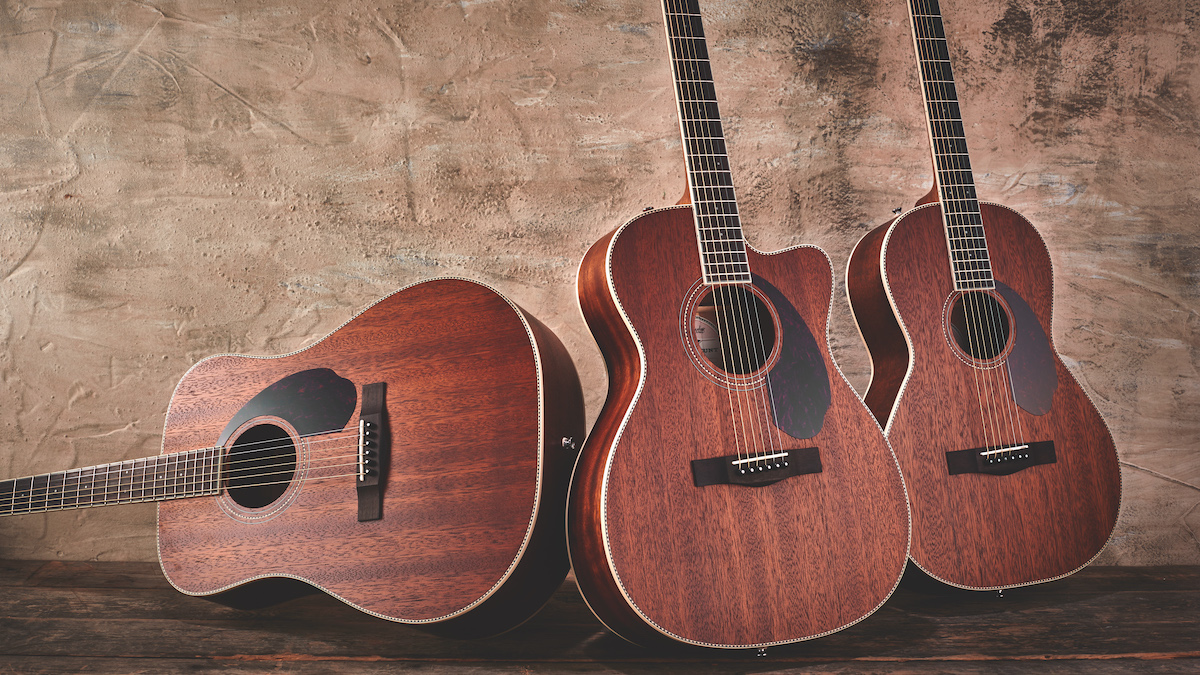
Are Fender acoustic guitars good quality?
Although Fender isn’t as popular in the acoustic world, this doesn't mean its acoustic guitars are of any less quality. Quite the contrary. Having so much experience in the guitar industry comes with its advantages. With decades of experience, it has a wealth of guitar knowledge at its disposal and employs some of the finest craftsmen in the world.
Sure, Fender does produce entry-level models which may use less expensive materials, but you can rest assured that most of the time their acoustics will be reliable, playable, and produce a satisfying tone. If you are more interested in exotic woods, intelligent electronics and premium accessories, Fender has that up its sleeve too. The American Acoustasonic range is one of the most advanced acoustic guitars on the market, utilizing impressive materials with a price tag to boot.
So no matter where you are on your acoustic guitar journey, Fender will have a good quality guitar to suit your needs and wants.
Does solid wood make a difference on acoustic guitars?
When reading about acoustic guitars, you may notice a big emphasis on ‘solid wood’, but why do acoustic guitar players care so much about this? Well, the answer is tone. As the name suggests, solid wood is the term used to describe a totally natural piece of wood that has not been synthetically constructed. The antithesis of this is laminated wood. Which has been synthetically constructed and is made up of layers of wooden veneers – a very thin piece of sliced wood – glued together.
Solid wood is the most sought-after on acoustic guitars as it produces a much more resonant and rich tone compared with a laminated piece. Solid wood’s natural construction vibrates more, which allows the wood to move more freely allowing for a greater transfer of energy between the guitar strings and the wood. Sonically, this is much more pleasing to our ears and sounds richer.
However, laminate wood has its positives also. Laminated wooden tops on acoustic guitars are very robust and can take a knock or two. This makes it ideal for a young beginner who may be a little clumsy. It is also a lot cheaper to produce, allowing for less expensive guitars to be made.
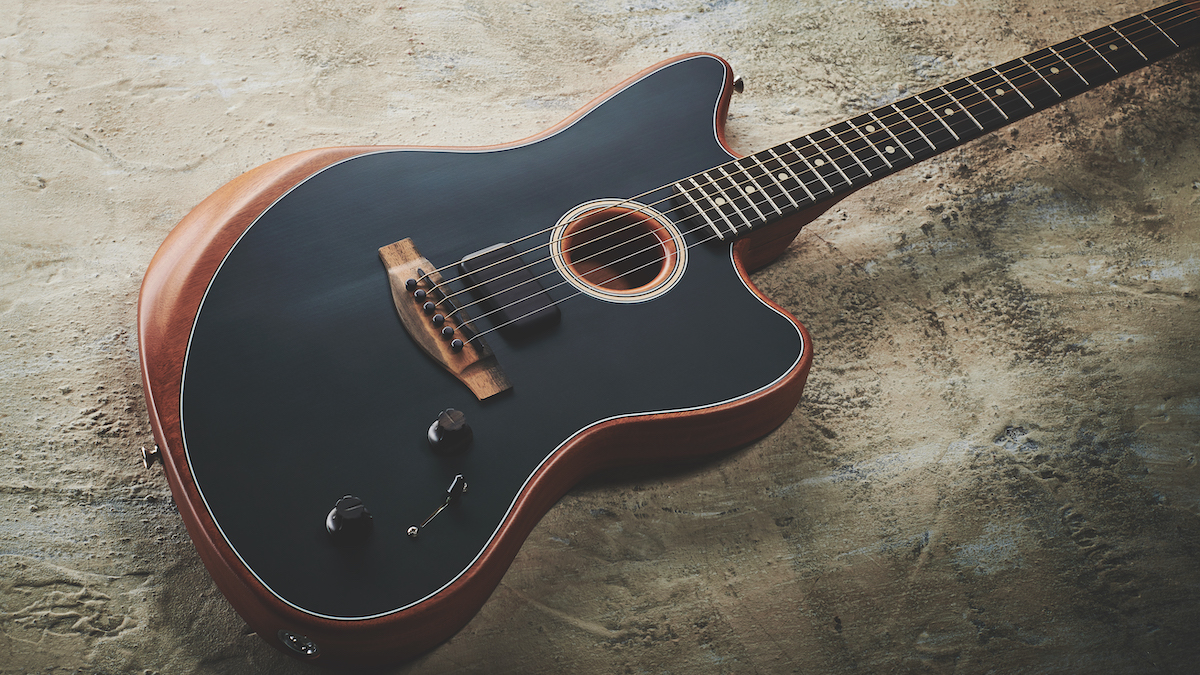
Where are Fender acoustic guitars made?
Much like their electric guitars, Fender acoustics are made all over the world. Depending on which series you decide to go for will determine where your guitar is made. For example, Fender spreads production of their entry-level to intermediate acoustic guitars between factories in China and Indonesia. The FA series, CD series, Paramount series, and Fender classic design series are all produced in China or Indonesia.
Recently, Fender's Ensenada factory in Mexico expanded its repertoire to include acoustic guitar production. Now, the Ensenada factory proudly produces the Player Acoustasonic. For those looking for American-made acoustics, the American Acoustasonic series is handcrafted in California with a level of care and precision that is second to none.
How we choose the best Fender acoustic guitars
You can trust Guitar World
Here at Guitar World, we are experts in our field, with many years of playing and product testing between us. We live and breathe everything guitar related, and we draw on this knowledge and experience of using products in live, recording and rehearsal scenarios when selecting the products for our guides.
When choosing what we believe to be the best Fender acoustic guitars available right now, we combine our hands-on experience, user reviews and testimonies and engage in lengthy discussions with our editorial colleagues to reach a consensus about the top products in any given category.
First and foremost, we are guitarists, and we want other players to find the right product for them. So we take into careful consideration everything from budget to feature set, ease of use and durability to come up with a list of what we can safely say are the best Fender acoustic guitars on the market right now.
Read more about our rating system, how we choose the gear we feature, and exactly how we test each product.
Related buyer's guides
- Best Fender amps: from tube combos headphones amp solutions
- Best Stratocasters: Strats for every budget and playing style
- Best Telecasters: budget-spanning Fender Tele top picks
- Best Squier guitars: budget Strats, Teles, Jags and more
- Explore our pick of the best Yamaha acoustic guitars
- Best Gibson acoustic guitars: acoustics for all styles of player
Get The Pick Newsletter
All the latest guitar news, interviews, lessons, reviews, deals and more, direct to your inbox!
Ross has been a music lover and guitar player since the age of 8. He has spent the five years since graduating from university working in music retail, selling guitars, amps and more. Ross is particularly interested in electric guitars, pedals and amplifiers and his current rig includes a trusty 2009 American Standard Stratocaster and Vox AC30S1 with a few Walrus Audio and Way Huge pedals in between.
“While the odd corner has clearly been cut, these are true Gibsons with all the individuality that this brand exhibits”: Gibson J-45 Special and Hummingbird Special review
“Fender has stripped back the price – but has it gone too far paring back the sounds, too?” Fender Standard Acoustasonic Telecaster review











